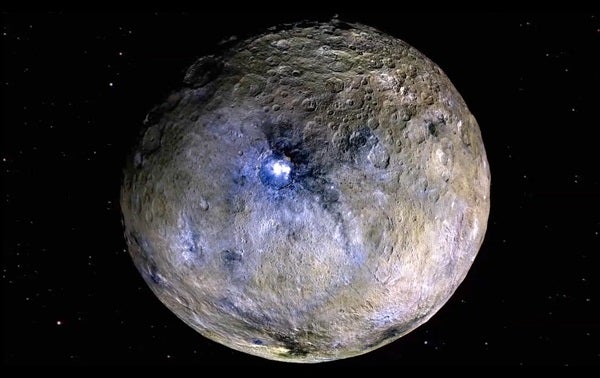“More and more, we are learning that Ceres is a complex, dynamic world that may have hosted a lot of liquid water in the past, and may still have some underground,” said Julie Castillo-Rogez of NASA’s Jet Propulsion Laboratory (JPL) in Pasadena, California, in a press release. Castillo-Rogez is both a Dawn project scientist and co-author of the recent studies.
Gravity anomalies
Gathering data on Ceres’ composition is difficult — the Dawn spacecraft is not designed to land on the dwarf planet, so measurements of its gravity are instead translated into compositional information. This is achieved by studying tiny variations in Dawn’s orbit as it circles the world; these variations can then be associated with specific features on or below Ceres’ surface: “gravity anomalies.”
The first recent study of Ceres, published in the Journal of Geophysical Research and led by Anton Ermakov of JPL, found that “Ceres has an abundance of gravity anomalies associated with outstanding geologic features,” he said. Many of these features, such as Occator, Kerwan and Yalode craters and the mountain Ahuna Mons, are associated with cryovolcanism and its effects, highlighting the importance of such geologic activity in shaping the small world.
Additionally, the data indicate that Ceres’ crust has a low density more similar to ice than rock. However, Ceres’ crust is also relatively hard — so it raises the question, how can it be both?
Ceres’ gravity field, shown in false color, contains “anomalies” associated with surface features. On this map, red indicates stronger-than-expected gravitational pull, blue less than expected.
NASA/JPL-Caltech/UCLA/MPS/DLR/IDA
Hard but light
This question is answered by a second study, led by Roger Fu at Harvard University in Cambridge, Massachusetts, and published in Earth and Planetary Science Letters. In this study, researchers looked to the dwarf planet’s topography to provide clues about its composition.
By modeling the way Ceres’ topography has changed over time, they concluded that the crust contains ice, salts, and rock. It also contains clathrate hydrate — a water-based solid that is essentially a gas molecule locked inside a “container” formed by water molecules. Clathrate hydrates are much stronger than water ice, yet still have a low density, exactly like the crust of Ceres.
The researches also believe Ceres once had much starker, more pronounced features, which have since been flattened. This flattening is due to a deformable layer just beneath the hard crust — and that deformability, researchers think, likely comes from the presence of at least some liquid water. That liquid is only the residual of what might have been a once-global ocean, most (but not all) of which is now frozen into the crust.
These findings both point to liquid water in Ceres’ past and present, a picture consistent with models showing the dwarf planet still contains liquid from that ocean, deep down. Dawn’s ongoing observations continue to support these models, helping us piece together the history of this unique solar system world.










